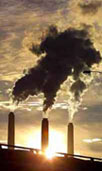
The
European Union market for permits to emit carbon dioxide has gyrated in past weeks as it became clear that national governments gamed the initial permit allocation and EU officials
bumbled the release of information on actual emissions. But people concerned about climate change, especially its effects on developing countries, need not worry. The EU carbon market is still an historic model for what the whole world must do to combat climate change. The details are arcane, so the big picture first.
The
1997 Kyoto Protocol is an extension to the
Framework Convention on Climate Change, the "Earth Summit” treaty signed at Rio de Janeiro in 1992. The Kyoto Protocol committed industrial nations, including former Eastern bloc nations, to cut average annual emissions of carbon dioxide in 2008-12 by 5.2% from their 1990 level. Notably, the target applies to these nations as a group. That opened the way for trading between nations in the right to pollute. Thus the United States, whose SUV fleet was growing, could buy from Ukraine, whose industrial economy was collapsing, the right to emit millions of extra tons of greenhouse gases. It might exceed its Kyoto reduction target. But since Ukraine would stay well within its own limit, so would industrial nations as a group. After all, it matters not for global warming whether a ton of carbon dioxide enters the atmosphere from a tailpipe in Los Angeles or a smokestack in Ukraine's industrial Donetsk region. How such transactions might occur was left vague.
Of course, the United States has not yet ratified the Kyoto Protocol. But enough countries have, including EU members and Russia, for Kyoto to come into force among ratifying countries. To manage its emissions, the EU developed a carbon dioxide permit trading system that operates within its borders. In the EU scheme, each factory and power plant is allocated permits to emit a certain amount of carbon, based on past emissions rates. Companies that then reduce their emissions below their quotas can sell their extra permits to those wanting to exceed, through the carbon market.
Why bother? The market will tend to allocate the right to emit carbon to those companies for which burning fossil fuel is most valuable. A barely-profitable coal-fired power plant, for example, might go under because its owners can make more money by selling their carbon quotas, while an efficient, profitable natural gas–powered chemical plant might easily pick up more permits. The environment would be protected, and the price incentive would create a reward for technological innovation.
The EU system is young, and it became increasingly clear this month that most EU nations gave their power plants more permits than they actually needed for now. Why? Each member of the EU had an incentive to exaggerate its needs in the competition for slices of a limited pie, in order to cushion its own businesses. But an EU-wide surplus could send the carbon emission price toward zero. The betting in the market, then, was about how big the surplus would be. Partial data scheduled for release on Monday was accidentally posted Friday, and it painted a dire picture, so the price of December 2006 carbon emission rights plunged another 28% that day, from €12.85 to €9.30. But more-complete data on Monday was more bullish: the surplus was smaller than thought. So on Monday, carbon closed up a spectacular 85% at €17.25. (
See graph.)
Such accidents and gyrations point up that the carbon market and its managers are still finding their way. But that is a passing problem. Indeed, the current 2005-07 period is considered a trial phase. The next phase, for 2008-12, lines up with the Kyoto Protocol commitments and will be more serious.
The long view is what matters here. A carbon market in some form is nothing less than one of the most important solutions to one of the most important problems of our age. I argued in my book,
The Natural Wealth of Nations, that it will be virtually impossible to stop global warming without such a mechanism. “Averting climate change…will require that industrial countries cut carbon emissions--caused mainly by burning fossil fuels--90 percent. These changes will affect where people live, how they move about, and how they make everything from bottles to buildings.” No government can plan that. "Markets, on the other hand, excel at engineering systemic change.” Carbon taxes can also be used to create market signals. But permit trading is more palatable. Evidently there is a surplus of copies of my book: it can be had via
Amazon for 47 cents.
CGD blog posts reflect the views of the authors, drawing on prior research and experience in their areas of expertise.
CGD is a nonpartisan, independent organization and does not take institutional positions.


 The
The 


